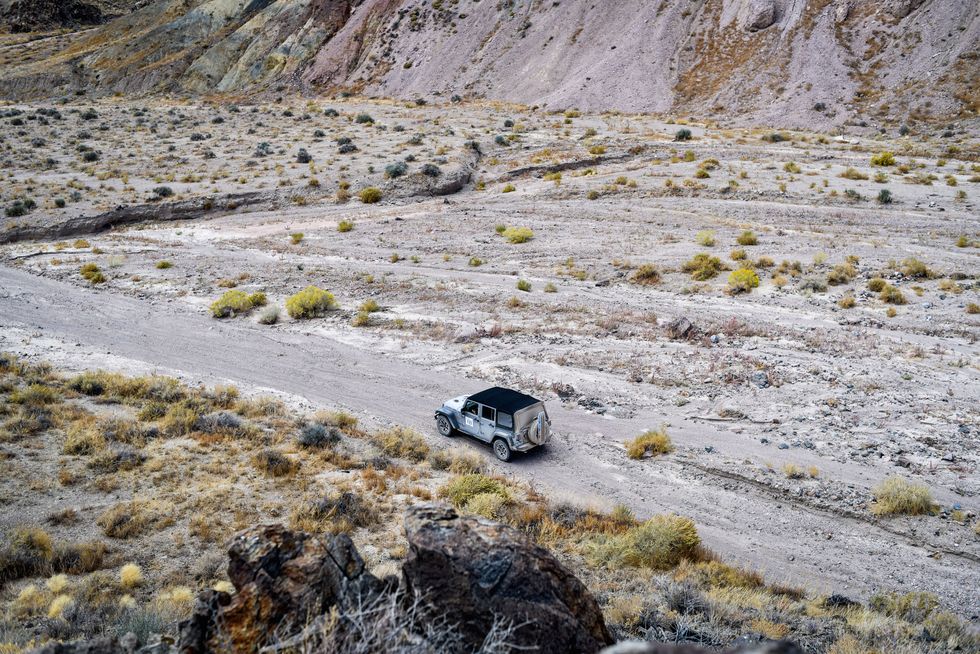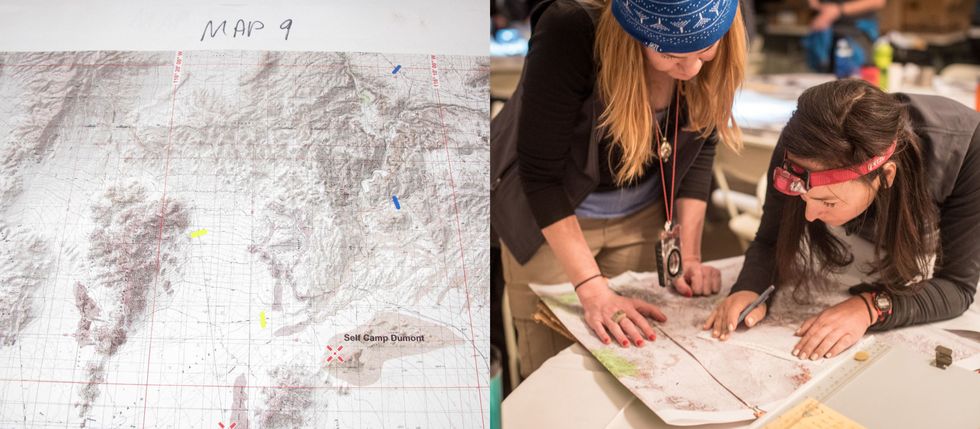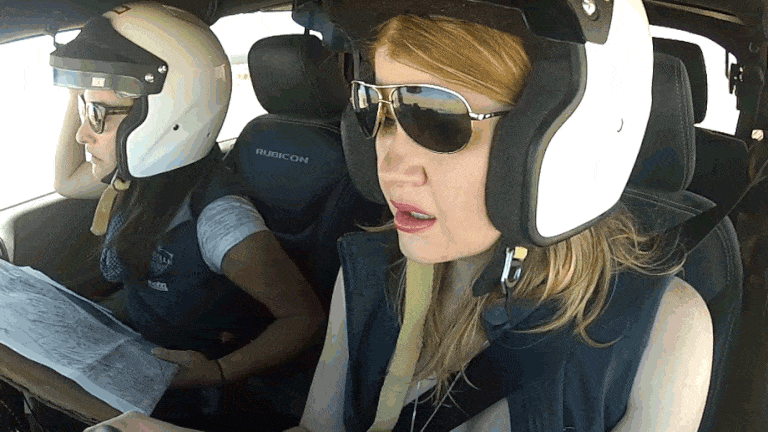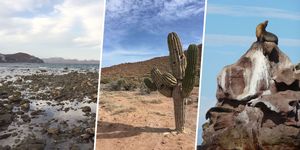72 Women. 1250 Miles. No GPS.
I competed in America's first all-female endurance road rally. I'd never even changed a tire.

It was 4 p.m. and 90 degrees when we finally decided to give up. For hours, Jaclyn and I had been inching our Jeep Rubicon along a dusty unmarked road in the Mojave National Preserve, eventually finding ourselves trapped in a high-walled canyon. We had no idea how far off course we were: Two miles? Twenty? We hadn't seen another human all afternoon. Soon it would be dusk, then nightfall.
We were lost. Not Can you pull up Google Maps? lost, or Do we still have a road atlas somewhere? lost. No, we were Are we in California or Nevada? lost; Thank god we have emergency supplies lost; This landscape would be gorgeous if it weren't so apocalyptic lost. The Jeep's GPS system had been disabled, and our phones and laptops were turned off and sealed in envelopes. We had a collection of specialized large-scale topographical maps, but to figure out where you are on a topo map (a relief map that shows a region's geographical features), you have to know how to read it. I was supposed to be the better topo reader in our pair, and I could barely pick out the most prominent landmarks. If coyotes or unfriendly strangers appeared, we'd be completely, royally screwed.

Is that the road?
We sat in the Jeep with the air conditioning on high, eating sugary energy chews and gulping down coconut water.
We'd signed up for this. Willingly. For fun.
That was day four of the inaugural Rebelle Rally, a female-only navigational road rally—the first of its kind. For seven days last fall, 72 women—36 teams of two—off-roaded over 1250 miles, through two national parks and five Bureau of Land Management areas (government-managed public lands). We started in Nevada's Lake Tahoe and ended in Glamis, California; in between, we rambled down dirt roads, clambered over dry riverbeds and mountain passes, and coasted over terrifyingly high sand dunes.
This all called for a set of navigation skills no one uses anymore—unless you're a sailor or a fifth grader prepping for a social studies test.
Throughout the course, 140 checkpoints were hidden behind broken-down mine shacks, just beyond hairpin turns, deep inside mountain crevices, and sometimes, blessedly, directly on the route. Large green flags marked the easiest-to-find checkpoints; smaller blue flags identified intermediate ones. Black checkpoints, the most difficult to find, weren't marked at all. Each was worth a certain number of points. The goal: Rack up as many as possible.
Every morning we were given a list of checkpoints to find that day (one day there'd be 12; another day, 22), defined solely by their latitudinal and longitudinal coordinates. We had to plot them on our topo maps, then use geometry to strategize how to get from one to the next. This all called for a set of navigation skills no one uses anymore—unless you're a sailor or a fifth grader prepping for a social studies test. We weren't allowed phones, GPS, or outside help. Kind of like an adult female Eagle Scouts on steroids, or Survivor meets The Amazing Race in the American West.
Get exclusive access to fashion and beauty trends, hot-off-the-press celebrity news, and more.

One of our topo maps; early morning plotting at camp.
The automotive world is notoriously male-dominated, making a women-only motorsports event revolutionary. (There are a few all-women rallies and races scattered across the globe, out of hundreds of annual motorsports events overall; the Rebelle is the only one in the U.S.) "I've been in races where I was the only woman driving," the Rebelle's founder, 50-year-old Emily Miller, told me. "I've had people recommend I wear a tight pink race suit."
Miller grew up between Arkansas and Colorado, skiing, biking, and reading her father's car magazines. In her 30s, she launched a sports marketing firm and started to race cars and teach at racing and off-roading schools. When creating the Rebelle—which took three years of planning, 40 Bureau of Land Management permits, and 60 staffers to pull off—Miller combined her favorite aspects of the rallies and races she'd participated in over the years.
RELATED STORY

She was determined to create an event where women could test their mettle. "Most automotive events are designed from a man's perspective," Miller said, meaning that they're usually speed races, where the goal is to get from Point A to B as fast as possible. But the Rebelle isn't a race, she reminded us daily. It demanded endurance, accurate navigation, and communication. "Women excel in endurance events," she explained. "Women think about the rules and the challenge. They want to win, but they're not there to prove how fast they can go."
My team's combined experience was…limited. "Winning" never crossed our minds; we just hoped to finish without killing the Jeep—or one another. My teammate, Jaclyn Trop, is an auto reporter who reviews luxury cars, but we both quickly realized that her professional expertise didn't translate into real-world driving and car maintenance knowledge. While she knows her way around a racetrack, she didn't know how to read a map.
Naïve enthusiasm seemed like a perfectly legitimate qualification to enter a highly-detailed endurance event requiring a complex Venn diagram of skills I didn't possess
Not that I know anything about cars. I can sort of drive a stick shift, and sort of change a tire. I'd signed up for the Rebelle Rally because tooling around isolated Southwestern back roads is one of my all-time favorite activities, something I discovered during the six years I lived in Far West Texas. (Aimless desert driving is terrible for the environment, but good for the soul.)
At first, my lack of experience didn't faze me. Naïve enthusiasm seemed like a perfectly legitimate qualification to enter a highly-detailed endurance event requiring a complex Venn diagram of skills I didn't possess. This blind optimism buoyed me for months: the Rebelle was just a crazy-sounding adventure, far off in the distance, something to think about later.
But six weeks before the rally, during a training weekend with a handful of other competitors in California's Borrego Springs, my optimism cratered into a black hole of fear and self-loathing. Surrounded by women far more experienced than me, all of whom could probably MacGuyver a tire blowout with a piece of gum, my lack of preparation smacked me in the face. Latitude and longitude felt like a maddening mathematical language I'd never master, and I didn't believe that Jaclyn or I would have the stamina and resilience to handle potential crises. (I live in Brooklyn! I don't even have a car!) Instead of bonding with the other participants, I disappeared into my tent, clutching my iPhone for comfort. Miller stopped by: "You okay?" she called from outside my tent. "Yeah," I squeaked. "Just tired." This is going to be a disaster, I told myself. You didn't think this through.

I was certain the rally would bring out my worst self. I'd be a dehydrated raw bundle of neuroses, throwing my helmet in the dust and indulging in nonstop Carrie Mathison-like angry-crying. I spent the month before the rally nursing a never-ending migraine, holing up at home ruminating on my certain failure, and having bouts of ill-advised anxiety sex with a highly inappropriate partner I thought I'd successfully sworn off months before.
"It's only overwhelming because you've never done it before," my mother, always a voice of reason, said. "Once you're there, you'll get in the swing of it. You'll be fine. You always are."
The rally began on a Saturday morning in early October, but Jaclyn and I arrived in Lake Tahoe—bright and sunny and permeated with the smell of pine—on Tuesday night to prepare. Buying our required provisions took an entire day: We'd need a five-gallon jug of water, emergency blankets, a fire extinguisher, first aid kits, food to last at least five days (in case something went terribly awry), a laundry list of auto supplies, and helmets—required for safety's sake whenever we were on the Rebelle course—that squished our faces into chipmunk-cheek blobs. Thursday was "technical inspection," during which rally staffers ensured each vehicle was properly equipped. On Friday afternoon, all 36 teams caravanned out to our first base camp, a sprawling settlement a few hours east of Lake Tahoe, with a vehicle impound, a maintenance tent and gas refill area, a food truck manned by a Michelin-starred chef, and the main gathering space—a shelter filled with tables and butterfly chairs, decorated with gauzy curtains and wildflowers.

Miller briefs competitors; a green checkpoint on the course; Rebelle cars on a dry lake bed in California.
I woke on Saturday at 4:30 a.m. and launched into what would become my daily routine: wiggling into my Rebelle uniform (sports bra, tank top, long-sleeved shirt, hiking pants, lace-up canvas boots), rushing to the portable bathrooms to brush my teeth and splash water on my face; running back to pack up camp. While I dragged our gear down to the Jeep, Jaclyn picked up the day's list of coordinates and started plotting. I joined her under the main tent, staring helplessly down at the table where she'd spread the coordinate list, colored pencils, and distance-measuring rulers.
We experienced the singular thrill of spotting a green checkpoint: a mix of relief, pride, and elation that never got old.
Jaclyn understood latitude and longitude in a way I didn't, so it was obvious that she'd be the navigator, while I'd drive. We crept up to the starting line, my heart beating wildly from nerves, and waited to be let loose into the desert. (To discourage blindly following other competitors, teams were given different sets of checkpoints, and cars set off at two-minute intervals.)
"Turn left," Jaclyn said once we set off. "Our first checkpoint should be in 13 miles." A few minutes later, we experienced the singular thrill of spotting a green checkpoint for the first time: a mix of relief, pride, and elation that never got old.

Later that afternoon, after meandering through a maze of dirt roads, we turned into a wide canyon, shot through with dry washes (empty creek beds that can easily be mistaken for trails or roads). "Should we be in four-wheel drive?" Jaclyn asked. Four-wheel drive gives you extra traction; it's used for rougher, rockier terrain. I felt silly for still being in 2WD—the everyday, highway-driving gear—and jerked the gear shaft up. We slowly rambled through the canyon down to a lake, where we found our final green checkpoint of the day.
We hit our tracker—sending our coordinates to staff at base camp, who monitored each vehicle, just blinking blips, on a GPS system—then realized that we'd fallen behind the other competitors. We could only see one team, off in the distance in a huge pickup. We watched as they scaled an incline effortlessly, as if filming a car commercial.
"If they can do it, so can we," I said, hitting the accelerator and heading up the incline. Within 30 seconds, our tires started to spin. Day one, and we were already stuck. We grabbed shovels from the back of the Jeep and started clearing dirt from underneath the tires. Nearby, a rally staffer pulled up in a pickup.
RELATED STORY

"Are you in four-wheel drive?" he asked.
"Of course," I answered.
"You sure?" he said. "I'm not supposed to help you, but…you might want to check."
We climbed back inside the Jeep: the gear shift looked like it was in the right place. Jaclyn pulled the manual out of the glove compartment. "It says we should see a 4WD light on the dashboard. Do you see it?"
"Oh," I said. "No." Hours spent crawling over boulders and sharp rocks, and we'd been in the wrong gear the whole time, an embarrassingly amateur mistake. We pledged not to tell anyone back at base camp.

Day One: stuck. (I promise this was steep IRL.)
By day four, we'd improved dramatically. We knew when we were and weren't in four-wheel drive. We knew that our odometer was off, making precise calculations nearly impossible—a significant drawback. And we knew that spotting a particular road on our topo map didn't mean we could match it to one on the ground. What looked like a road on the map could be a dry wash; what looked like a dry wash on the ground could be a road. We constantly scouted the horizon for dust clouds, knowing they'd be from Rebelle cars, a sign that we were on the right track.
Then came our accidental vision quest in the Mojave, when we'd drifted so far off-course that we hadn't seen a friendly dust cloud for hours.
After mainlining the energy chews, we got out of the Jeep to scout. Jaclyn jumped on the hood to survey our surroundings; I took off by foot. A railroad crossed in front of us, with a steep drop-off underneath. We were definitely stuck.
Then I saw it: a campsite, off in the distance, across a weedy wash. Trucks! People! A dog! Life!
I found Mojave River Campground in miniscule print in the lower left-hand corner of the map. So that's where we were. "If we can get to that campground, we could find our way to the highway," I said. It wasn't our designated route back to base camp, but the sun was dropping by the minute.
The weedy wash was actually the Mojave River, according to the map. It wasn't a river so much as a morass of swampy vegetation with a lone, murky crossing. Back home in Brooklyn, in my haste to somewhat prepare, I'd watched a YouTube video of a Jeep wading through water. I knew it was possible; I just didn't know if I could do it. "No way," Jaclyn said. "We're not going to drown here."
"What if it's easier than it looks?" I argued.
Jaclyn thought for a minute. "What would Emily do?" she asked. Miller is a 5'1" blond powerhouse who gave decidedly non-cheesy pep talks every night that sometimes brought me to tears. I'd never met anyone who inspired such devotion and admiration, who made you want to succeed just to tell her you had. "If this was easy, everyone would do it," she told us repeatedly, and we felt like intrepid, ground-breaking explorers.
Miller encouraged calculated risks. "Emily would try it," I said. "But I think she'd check the depth first."
I stripped off my boots, socks, and pants. In just a tank top and underwear, I splashed into the crossing, mud squishing beneath my toes. The water quickly came up past my knees. I pictured the Jeep filling up with contaminated river sludge while Jaclyn and I popped Klonopin and prayed that the satellite phone actually worked.
If this was easy, everyone would do it," the Rebelle's founder told us repeatedly, and we felt like intrepid, ground-breaking explorers.
Okay, so we weren't going to ford the mighty Mojave. But at least now we knew where we were. (Another favorite Emily saying: "You're never as lost as you think you are.") From the map, the highway back to base camp was vaguely northeast; if we headed that direction, we'd surely find a way onto the road.
Two interminable hours later, we saw what we'd been looking for all afternoon: the day's final green flag, and behind it, the entrance to the highway. Our euphoric shouts were especially hard-earned this time. As we approached the highway, a car pulled up alongside us. "Thank God!" Shelley, a rally staffer, yelled out from the passenger seat of a broken-down '80s Jeep. "We found you!" Apparently, the staff back at base camp monitoring our blinking blip had become concerned: Where are they going?
"We thought we'd have to rescue you," her husband, Big Rich, called from the driver's seat. "But look: You rescued yourselves."
On the face of it, the day was a complete throwaway. Zero points. But we'd found our way out of the canyon, completely on our own.
My month-long pre-rally panic, while overblown and unsubstantiated in retrospect, served a purpose: It burned out all my anxiety, leaving none for the actual rally. The meltdowns never came. I never threw my helmet in frustration. I didn't angry-cry nonstop. Jaclyn and I each had one brief tearful moment after making a dumb mistake—hers on day five; mine on day six—but we immediately pulled it together.

As usual, my mother was right. Once I was forced to practice my fledgling skills, my fear melted away, replaced by an unabashed excitement that at times bordered on euphoria. Every moment brought something new: a stunning vista, a mountain pass, an abandoned ghost town, an expansive mesa. The entire course was on government property; these same roads were open to anyone. But they're rarely used, and it felt like we were seeing an America many never do, one hidden in plain sight.
I started to trust the Jeep more, and Jaclyn, and myself. One day we were caravanning along a high ridge outside of Joshua Tree, with steep drop-offs and hairpin turns. Wait! I thought, halfway through. I should be scared. If I turn the steering wheel just slightly, we'll sail off. I felt my stomach drop and panic rise up in my chest. But just as quickly, I reeled it back in. Don't let fear take over, I coached myself. You can stop it. "You're already way more confident," Jaclyn noted as we dipped and swerved. "If we'd been on this road the first day, you would've freaked out the whole time. Now you're just trucking along."
We were too clueless to be embarrassed about how little we knew.
I'd been so intimidated by the other competitors' credentials before the rally began, but now our lack of experience felt almost freeing. The rally was so out of our league that I was constantly astonished we were doing it at all. How we looked to anyone else didn't matter. We'd ask other Rebelles basic car-maintenance questions, knowing our queries probably sounded elementary. (Only one woman looked at us in disdain after we'd asked for her help installing high neon flags required for dune driving: "You actually don't know how to do this?" she spat. "Why are you even here?") We were too clueless to be embarrassed about how little we knew.
Every night, when the scores for the day were posted, we'd land in the bottom four. But we thought we were champions.
RELATED STORY

All week, the experienced competitors were itching for the final day, when we'd be competing in sand dunes—notoriously difficult to navigate. We woke up that last morning in California's Imperial Sand Dunes (where Return of the Jedi was partially filmed) to a blazing sun, a high in the 90s, and a range of shimmering white sand mountains towering over base camp.
I didn't feel particularly ambitious about the dunes, but Jaclyn wanted to attempt some final point-collecting. We caravanned with a few competitors, helping each other find the safest routes, then ate lunch around a green checkpoint, sitting in the shade cast by our vehicles. It was our last green of the rally.
But when I stood up, I saw the top of a blue flag in the recess of a group of dunes to the south. I nudged Jaclyn: "Let's try it."

Dunes: gorgeous and terrifying.
We carefully coasted down into the dune's recess by circling the perimeter, as we'd been taught, and clicked our tracker for the last time. The incline we'd just descended looked much higher than I expected, but it was still the easiest way out. I backed up a few feet to give us a running start, then slammed down the accelerator. Halfway up the incline, we felt our wheels spin, digging us into the sand below. We frantically tried to dig out, but as soon as we cleared a space, new sand spilled in.
Two of the Rebelles we'd teamed up with, Sedona and Maria, flew down into the recess, clicked their tracker at the blue flag, and zipped up the incline past us with no trouble. They parked on the dune's crest, then ran down to help dig us out. Finally we had enough room behind our back tires to position our MaxTrax, a pair of ridged, snowshoe-shaped rescue tools, behind our back tires. Slowly, carefully, we eased off the sand and onto the MaxTrax.
Many of my pre-rally fears came true. But I found an intoxicating freedom in taking on a challenge just to take it on, without expecting conventional success.
Sedona pointed out the angle she'd taken: "Back up even more, then punch the accelerator harder," she suggested.
I'd driven for 90 percent of the rally, but I didn't want to attempt the incline again. "I'm scared," I told Jaclyn.
We switched places and she revved the accelerator. Miraculously, she caught enough power to follow Sedona's route. We landed on top of the dune, tumbled out of the Jeep, and grabbed Sedona and Maria for a hug, jumping up and down, triumphant.
In the end, we tied for 29th place, fourth-to-last. And many of my pre-rally fears came true: We made careless mistakes and incorrect calculations; we were lost more often than not; we didn't know what we were doing most of the time. I just didn't react the way I'd assumed I would. Instead, I found an intoxicating freedom in being a complete novice, taking on a challenge just to take it on, without expecting conventional success. I'd never been more exhilarated to fail.

Finish-line euphoria
The second annual Rebelle Rally will be held from October 12-21, 2017. If you're interested in competing, find more information here.
